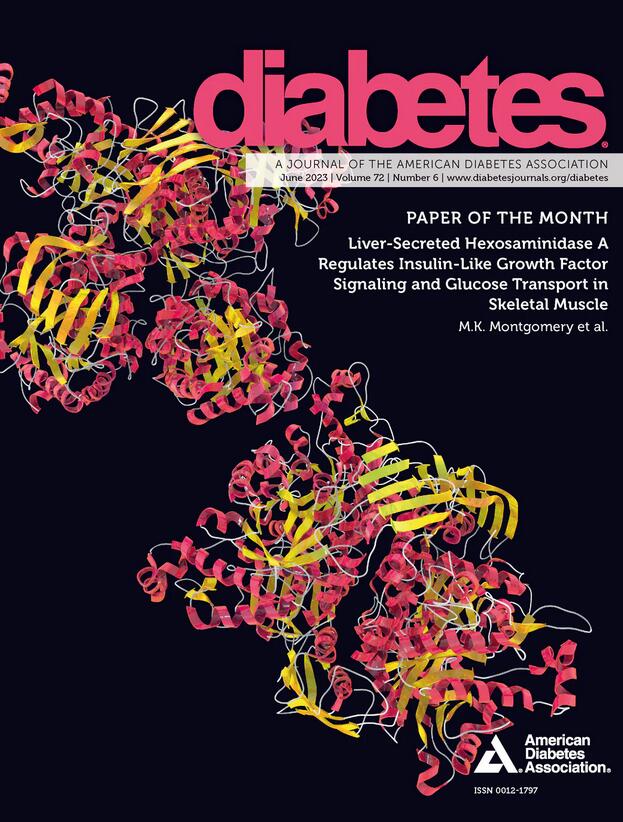Trem2+ Macrophages Alleviate Renal Tubule Lipid Accumulation and Ferroptosis in Diabetic Nephropathy by Repressing IL-1β–Mediated CD36 Expression
IF 7.5
1区 医学
Q1 ENDOCRINOLOGY & METABOLISM
引用次数: 0
Abstract
The presence of macrophages surrounding lipotoxic tubular epithelial cells (TECs) is a hallmark of diabetic nephropathy (DN). Nevertheless, the mechanisms of communication between these cell types are not well understood. Previous studies have revealed a unique subset of macrophages that express triggering receptor expressed on myeloid cells 2 (Trem2) in kidneys of human patients and mice with DN. Here, we explored the characteristics and the function of Trem2+ macrophages in the progress of DN. RNA-sequencing of macrophages in kidneys of Trem2 knockout (KO) mice fed a high-fat diet plus streptozotocin (HFD/STZ) revealed functional enrichment of metabolic processes, cytokine production, positive regulation of extracellular signal-regulated kinase (ERK) cascades, and the regulation of phagocytosis. In vivo studies demonstrated that Trem2+ macrophages reduced lipid accumulation and mitigated ferroptosis of TECs in diabetic mice. Mechanistically, Trem2-deficient macrophages amplified the production of interleukin-1β (IL-1β) through activating the ERK signaling pathway. Furthermore, IL-1β triggered CD36 expression via the transcription factor NF-κB. Bioinformatics and functional assays showed NF-κB binds the CD36 promoter, which directly bound to the promoters of CD36 to facilitate its transcription. Inhibition of NF-κB blocked IL-1β–induced CD36 production. This mechanism is exacerbated in Trem2-deficient macrophages, which release excess IL-1β to activate NF-κB in tubular cells, promoting CD36-dependent lipid uptake and ferroptosis. Additionally, we found Trem2 plays a role in enhancing the phagocytosis and clearance of ferroptotic cells by bone marrow-derived macrophages. Altogether, our results suggest Trem2+ macrophages maintain homeostasis of the renal microenvironment and exert a protective function in DN. Article Highlights Levels of triggering receptor expressed on myeloid cells 2 (Trem2) in macrophages are increased in human patients and in mice with diabetic nephropathy. Trem2 suppresses the extracellular signal-regulated kinase signaling pathways, thereby inhibiting IL-1β production in macrophages. Macrophage Trem2 deficiency exacerbates tubular cell lipid deposition and ferroptosis by increasing CD36 expression in an IL-1β–dependent mannerTrem2+巨噬细胞通过抑制il -1β介导的CD36表达减轻糖尿病肾病肾小管脂质积累和铁下垂
巨噬细胞包围脂毒性小管上皮细胞(tec)是糖尿病肾病(DN)的标志。然而,这些细胞类型之间的通讯机制尚不清楚。先前的研究发现,巨噬细胞中有一种独特的亚群在人类DN患者和小鼠肾脏中表达髓样细胞2 (Trem2)上的触发受体。在此,我们探讨了Trem2+巨噬细胞在DN进展中的特点和功能。高脂饮食加链脲佐菌素(HFD/STZ)对Trem2基因敲除(KO)小鼠肾脏巨噬细胞的rna测序显示,代谢过程、细胞因子产生、细胞外信号调节激酶(ERK)级联反应的正向调节和吞噬作用的调节功能增强。体内研究表明,Trem2+巨噬细胞减少了糖尿病小鼠的脂质积累,减轻了TECs的铁下垂。机制上,trem2缺陷的巨噬细胞通过激活ERK信号通路,增加了白细胞介素-1β (IL-1β)的产生。此外,IL-1β通过转录因子NF-κB触发CD36的表达。生物信息学和功能分析表明,NF-κB结合CD36启动子,直接结合CD36启动子促进其转录。抑制NF-κB可阻断il -1β诱导的CD36生成。这一机制在trem2缺陷的巨噬细胞中得到强化,巨噬细胞释放过量的IL-1β,激活小管细胞中的NF-κB,促进cd36依赖性脂质摄取和铁凋亡。此外,我们发现Trem2在增强骨髓源性巨噬细胞对铁细胞的吞噬和清除中起作用。综上所述,我们的研究结果表明Trem2+巨噬细胞维持肾脏微环境的稳态,并在DN中发挥保护作用。人类患者和糖尿病肾病小鼠巨噬细胞中髓样细胞2 (Trem2)触发受体表达水平升高。Trem2抑制细胞外信号调节的激酶信号通路,从而抑制巨噬细胞中IL-1β的产生。巨噬细胞Trem2缺乏以il -1β依赖的方式增加CD36的表达,从而加剧小管细胞脂质沉积和铁凋亡
本文章由计算机程序翻译,如有差异,请以英文原文为准。
求助全文
约1分钟内获得全文
求助全文
来源期刊

Diabetes
医学-内分泌学与代谢
CiteScore
12.50
自引率
2.60%
发文量
1968
审稿时长
1 months
期刊介绍:
Diabetes is a scientific journal that publishes original research exploring the physiological and pathophysiological aspects of diabetes mellitus. We encourage submissions of manuscripts pertaining to laboratory, animal, or human research, covering a wide range of topics. Our primary focus is on investigative reports investigating various aspects such as the development and progression of diabetes, along with its associated complications. We also welcome studies delving into normal and pathological pancreatic islet function and intermediary metabolism, as well as exploring the mechanisms of drug and hormone action from a pharmacological perspective. Additionally, we encourage submissions that delve into the biochemical and molecular aspects of both normal and abnormal biological processes.
However, it is important to note that we do not publish studies relating to diabetes education or the application of accepted therapeutic and diagnostic approaches to patients with diabetes mellitus. Our aim is to provide a platform for research that contributes to advancing our understanding of the underlying mechanisms and processes of diabetes.
 求助内容:
求助内容: 应助结果提醒方式:
应助结果提醒方式:


